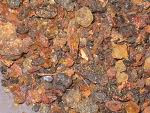Balsam oil was named by the ancient Greeks but the original balsam oil came from a now extinct persimmon tree. This oil was highly valued in the ancient world and used to anoint the kings of Israel in Biblical times. A jar of it was found in a cave near the Dead Sea in 1989 and there was enough oil left in the sealed jar for it to be analyzed.
These days the term balsam oil can be used to signify any seed plant that yields fragrant oleo-resin which is used in the manufacture of perfumes and medicines. This means that Abies balsamea and Canada balsam are balsam yielding trees. Moreover Balm of Gilead can come from trees or bushes that grow all over the world, but academics have put forward a fairly convincing theory that the gold of the gifts of the wise men to Jesus was in fact golden balsam oil. This actually makes a lot of sense as frankincense, myrrh and balsam yielding plants all grew in the same habitat.
A balm can be anything that soothes or heals, e.g. lemon balm, Melissa officinalis. It is confusing, but quite clear. The oil we now call Balm of Gilead is not the same as that of the ancient world. This oil is Balsam of Mecca- probably. Prosper Alpinus, a 16th century botanist and physician spent 3 years in Egypt and wrote in his “Dialogue of Balm” that 40 plants had been taken from the En Geddi groves of Balm of Gilead trees to a site close to Cairo. And these were from the Commiphora family of trees. He describes the balm of Gilead produced from these trees as smelling of “turpentine” but much sweeter and more fragrant, bitter and acrid to the taste and the oil, kept for some time, turns to a light greenish colour, then matures to a golden colour. He said that you could tell a true balsam because it would cling easily to the point of a needle.
 |
| by Berthold Werner Madaba Map, |
When archaeologists uncovered a mosaic map on the floor of a nave of a synagogue in Jordan, in Madaba in 1884, and since then there has been a puzzle about the “mysterious bush” that was in the mosaic along with date-palms. Dates were of great economic importance at the time and so it was logical to suppose was the bush. Joan Taylor and Nigel Hepper, in 2004 suggested that the bush was in fact the one from which the Balm of Gilead was obtained. This makes sense as the balm was one of the most expensive commodities in the ancient world, and much prized for its wound healing properties.
It has taken modern researchers until 2010 to support what the ancient physicians knew for a certainty, but what they knew the modern researchers are more careful about saying. David Iluzi et al have found that the oil from Commiphora gileadensis has antibacterial properties, so is useful for healing wounds, but more tests are needed before this can be stated with certainty.
The book of Jeremiah contains the following lament: -
Is there no balm in Gilead? Is there no physician there? Why then is there no healing
for the wound of my people?”
Legend has it that the trees that were grown on Mount Gilead were given to King Solomon by the Queen of Sheba, and also grew in the oases around the Dead Sea basin, in En Geddi and Jericho (also famous for its roses).Archaeologists found this dire warning on the mosaic floor of a synagogue at En Geddi: “Whoever reveals the secret of the village to the gentiles, the One whose eyes roam over the entire earth and see what is concealed will uproot this person and his seeds from under the sun.” The village was as highly fortified to guard the secret of the precious balm. It was really much more valuable than gold. This makes it likely that it was this golden balm that was given by the three Magi to the baby Jesus, as it grew in much the same areas as the frankincense and myrrh that were also gifts.
 Balm of Gilead of whatever kind has been used for centuries, for coughs, colds, sore throats, laryngitis, and applied externally to relieve the inflammation caused by arthritis and rheumatism. It is still used for labour pains and the dried bark of the trees is used for healing wounds. The Balsam of Mecca-bearing plants grow in Saudi Arabia, Oman, Yemen and Somalia.
Balm of Gilead of whatever kind has been used for centuries, for coughs, colds, sore throats, laryngitis, and applied externally to relieve the inflammation caused by arthritis and rheumatism. It is still used for labour pains and the dried bark of the trees is used for healing wounds. The Balsam of Mecca-bearing plants grow in Saudi Arabia, Oman, Yemen and Somalia. The Balm of Gilead trees in the US or Populus candicans or the Cottonwood which is a member of the Salicaceae family has many uses and even the buds can be used to treat ailments. In folk remedies the buds are used for a facial wash and for a tisane for coughs, colds and bronchial problems. The inner bark makes a tisane for eyewash and a blood tonic, while the roots can be boiled and used as a wash for headaches. If you inhale the steam from the boiled buds, this is good to clear nasal and bronchial congestion.
TISANE FROM THE POPULUS CANDICANS BUDS
1 cup boiling water
1 tbsp buds
Method
Boil the water and pour it over the buds. Leave this to steep for 15 minutes and drink a cupful 3 times a day for coughs, colds and flu.
When you pick the buds, pick leaves too and dry them for poultices for inflammation and skin problems.
This has Taste and is a Treat(ment).


















































